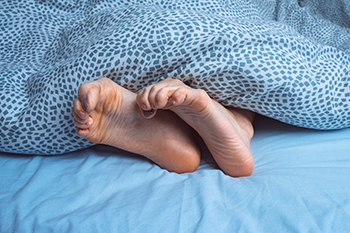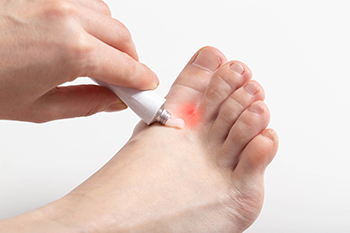
Foot cramps occur when the muscles in your foot or toes suddenly contract, leading to discomfort or pain. These foot cramps can happen to anyone, often striking at night or during periods of rest. While many foot cramps are harmless and resolve on their own, frequent or severe cramps may signal underlying issues. Possible causes include dehydration, deficiencies in minerals like potassium or magnesium, or overuse of the foot muscles. In some cases, foot cramps may be related to more serious health conditions, such as peripheral artery disease, diabetes, or nerve compression. Wearing improper footwear, like high heels or shoes that lack support, can also contribute to the problem. Preventive strategies include staying hydrated, ensuring adequate mineral intake, and choosing supportive footwear. However, if foot cramps become frequent or painful, it’s important to seek medical help from a podiarist. If you frequently experience foot cramps, it is suggested that you schedule an appointment with this type of healcare professional for a diagnosis and treatment options.
Foot Pain
Foot pain can be extremely painful and debilitating. If you have a foot pain, consult with one of our doctors from New England Foot & Ankle . Our doctors will assess your condition and provide you with quality foot and ankle treatment.
Causes
Foot pain is a very broad condition that could be caused by one or more ailments. The most common include:
- Bunions
- Hammertoes
- Plantar Fasciitis
- Bone Spurs
- Corns
- Tarsal Tunnel Syndrome
- Ingrown Toenails
- Arthritis (such as Gout, Rheumatoid, and Osteoarthritis)
- Flat Feet
- Injury (from stress fractures, broken toe, foot, ankle, Achilles tendon ruptures, and sprains)
- And more
Diagnosis
To figure out the cause of foot pain, podiatrists utilize several different methods. This can range from simple visual inspections and sensation tests to X-rays and MRI scans. Prior medical history, family medical history, and any recent physical traumatic events will all be taken into consideration for a proper diagnosis.
Treatment
Treatment depends upon the cause of the foot pain. Whether it is resting, staying off the foot, or having surgery; podiatrists have a number of treatment options available for foot pain.
If you have any questions, please feel free to contact our offices located in Wakefield, MA, Nashua and Derry, NH . We offer the newest diagnostic and treatment technologies for all your foot care needs.



 Athlete's foot,
Athlete's foot,